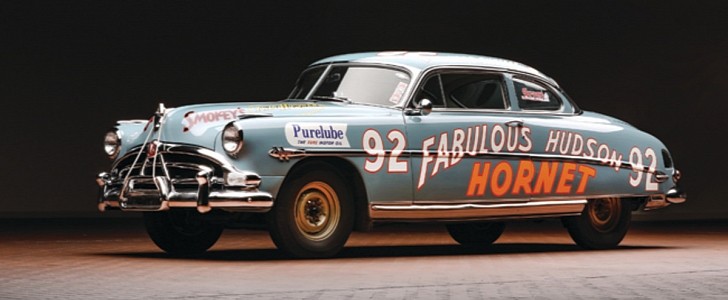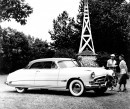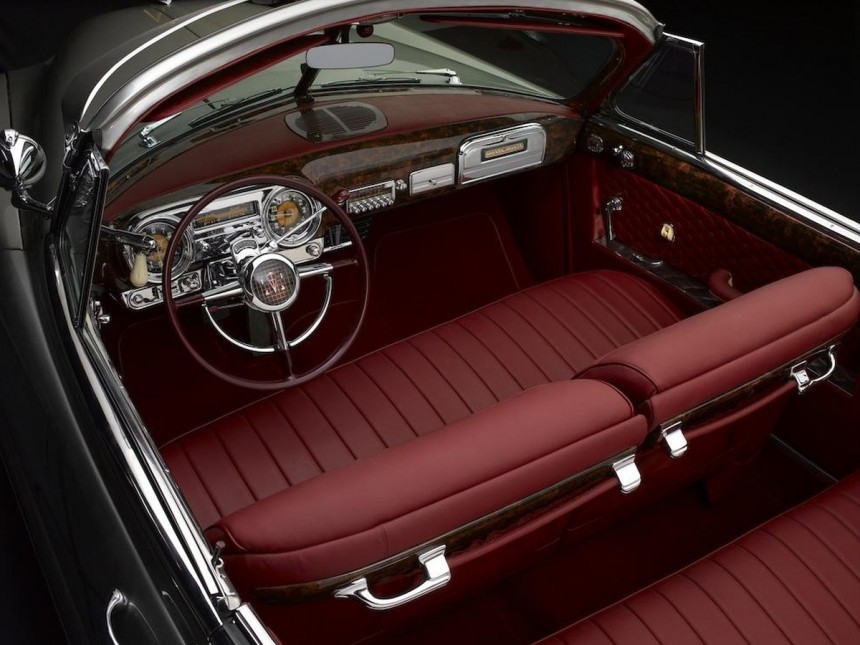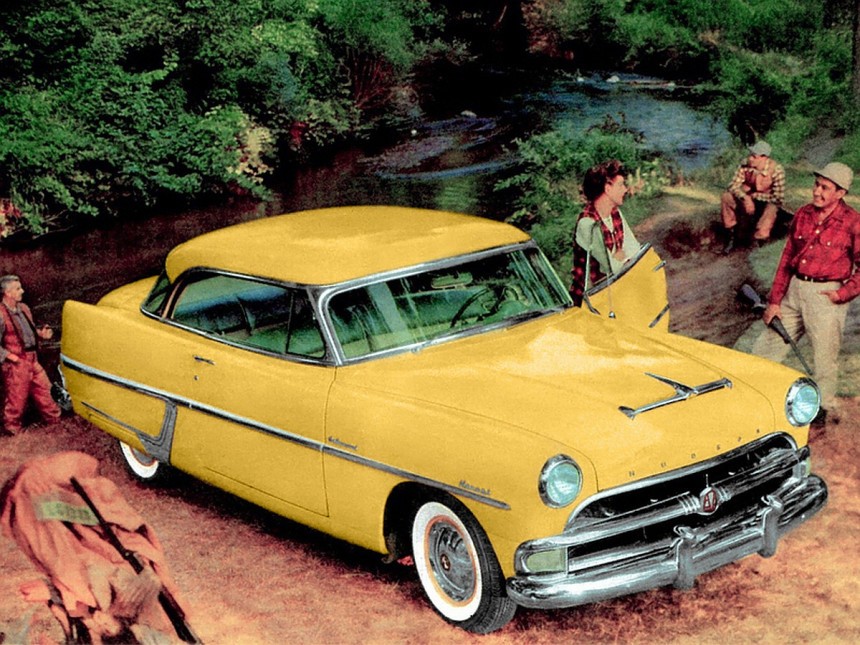Laid to rest in 1954, the Hudson Motor Car Company is largely forgotten now. Established in 1909, Hudson produced one of the first low-priced cars on the American market and became the third-largest U.S. automaker by the late 1920s.
Hudson also introduced many innovative features to the auto industry, including dual brakes, dashboard oil-pressure and generator warning lights, and the balanced crankshaft. But the Detroit-based manufacturer is mostly famous for the Hornet, a full-size automobile it launched for the 1951 model year.
One of the first production cars to feature a perimeter frame, the Hornet was based on the "step-down" design of the third-generation Hudson Commodore. It was called like that because unlike a unibody, this design didn't fully merge the body and the chassis into a single structure.
Instead, it featured floor pans that recessed down between the rails, which resulted in a lower-than-usual seating position. And since the floor was notably lower than the door sills, passengers had to literally step down into the vehicle, a unique feature at the time.
But the "step-down" design wasn't just a fancy gimmick. Even though it added to the Hornet's low-slung look and stylish cabin, it was actually more about functionality than everything else. The design lowered the car's center of gravity and enabled a silky ride and precise handling. Word has it that the Hornet was smoother than a Cadillac Series 62.
But while Cadillac and most Detroit brands were selling their cars with V8 engines, Hudson didn't have one. The Hornet was thus fitted with the company's high-compression H-145 inline-six engine. A 308-cubic-inch (5.0-liter) of the flathead variety, Hudson's mill was the largest mass-produced inline-six for passenger cars at the time.
Featuring a two-barrel carburetor, it was originally rated at 145 horsepower and 275 pound-feet (373 Nm) of torque, but Hudson upgraded it to 170 horses in 1954. It might not seem like a lot now, but the six-banger was no slouch for the early 1950s. Actually, Cadillac's 331-cubic-inch (5.4-liter) V8 was good for 160 horses at the time.
The Oldsmobile 88, powered by the iconic 303-cubic-inch (5.0-liter) Rocket V8, arrived with only 135 horsepower in 1949 before a four-barrel carb increased oomph to 160 horses. The 88 is often regarded as America's first muscle car, so it's safe to say that the Hudson Hornet played in the same league, despite hiding a straight-six under the hood.
But we don't even need to judge the Hornet by the numbers. Hudson's oversized inline-six played a key role in turning the two-door coupe version of the Hornet into a racing legend. As did Marshall Teague, the racing driver who convinced Hudson to join the NASCAR series and set up the first stock car racing team backed by a Detroit automaker.
A skilled mechanic, Teague tuned the Hornet's straight-six engine to its maximum stock capability, enabling the car to hit a top speed of 112 mph (180 kph), a spectacular figure at the time.
The Hornet made its first appearance on NASCAR courses in 1951 and just a year later it won the championship with Tim Flock behind the steering wheel. A second title followed in 1953, this time around with Herb Thomas at the helm. The Hornets dominated both seasons, winning a whopping 27 out of 34 events in 1952 and 22 of 37 races in 1953.
Hudson claimed 17 more wins in 1954 for a total of 64 victories (out of 108 races) in three seasons.
In the 1952 AAA season, Teague drove his Hornet to 12 wins in 13 scheduled events, finishing the championship with a 1,000-point lead.
Keep in mind that all of this happened in an era when stock car racers actually raced stock cars.
Unfortunately, the Hornet saga didn't last very long. Production ended in 1954, after only four years when a struggling Hudson agreed on a merger with Nash-Kelvinator. The resulting company, American Motors Corporation (AMC), closed Hudson's manufacturing plant and rolled out a second-generation Hornet based on a Nash platform. The Hornet was discontinued for good in 1957 when AMC also dropped the Hudson brand.
While not as celebrated as other Detroit-built cars from the early 1950s, the Hudson Hornet is indeed one of the great post-WWII automotive landmarks. And perhaps the only inline-six automobile that dominated a V8-packed racing series. An unlikely muscle car, a diamond in the rough.
One of the first production cars to feature a perimeter frame, the Hornet was based on the "step-down" design of the third-generation Hudson Commodore. It was called like that because unlike a unibody, this design didn't fully merge the body and the chassis into a single structure.
Instead, it featured floor pans that recessed down between the rails, which resulted in a lower-than-usual seating position. And since the floor was notably lower than the door sills, passengers had to literally step down into the vehicle, a unique feature at the time.
But the "step-down" design wasn't just a fancy gimmick. Even though it added to the Hornet's low-slung look and stylish cabin, it was actually more about functionality than everything else. The design lowered the car's center of gravity and enabled a silky ride and precise handling. Word has it that the Hornet was smoother than a Cadillac Series 62.
Featuring a two-barrel carburetor, it was originally rated at 145 horsepower and 275 pound-feet (373 Nm) of torque, but Hudson upgraded it to 170 horses in 1954. It might not seem like a lot now, but the six-banger was no slouch for the early 1950s. Actually, Cadillac's 331-cubic-inch (5.4-liter) V8 was good for 160 horses at the time.
The Oldsmobile 88, powered by the iconic 303-cubic-inch (5.0-liter) Rocket V8, arrived with only 135 horsepower in 1949 before a four-barrel carb increased oomph to 160 horses. The 88 is often regarded as America's first muscle car, so it's safe to say that the Hudson Hornet played in the same league, despite hiding a straight-six under the hood.
But we don't even need to judge the Hornet by the numbers. Hudson's oversized inline-six played a key role in turning the two-door coupe version of the Hornet into a racing legend. As did Marshall Teague, the racing driver who convinced Hudson to join the NASCAR series and set up the first stock car racing team backed by a Detroit automaker.
The Hornet made its first appearance on NASCAR courses in 1951 and just a year later it won the championship with Tim Flock behind the steering wheel. A second title followed in 1953, this time around with Herb Thomas at the helm. The Hornets dominated both seasons, winning a whopping 27 out of 34 events in 1952 and 22 of 37 races in 1953.
Hudson claimed 17 more wins in 1954 for a total of 64 victories (out of 108 races) in three seasons.
In the 1952 AAA season, Teague drove his Hornet to 12 wins in 13 scheduled events, finishing the championship with a 1,000-point lead.
Unfortunately, the Hornet saga didn't last very long. Production ended in 1954, after only four years when a struggling Hudson agreed on a merger with Nash-Kelvinator. The resulting company, American Motors Corporation (AMC), closed Hudson's manufacturing plant and rolled out a second-generation Hornet based on a Nash platform. The Hornet was discontinued for good in 1957 when AMC also dropped the Hudson brand.
While not as celebrated as other Detroit-built cars from the early 1950s, the Hudson Hornet is indeed one of the great post-WWII automotive landmarks. And perhaps the only inline-six automobile that dominated a V8-packed racing series. An unlikely muscle car, a diamond in the rough.















